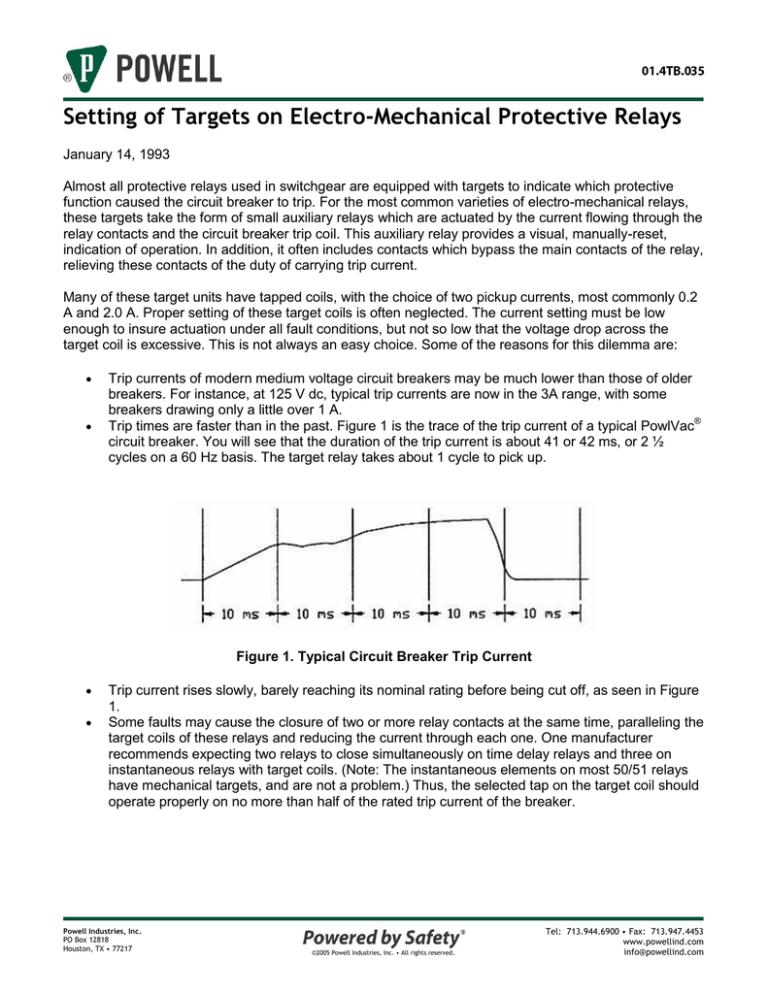
Setting of Targets on Electro-Mechanical Protective Relays
January 14, 1993
Almost all protective relays used in switchgear are equipped with targets to indicate which protective
function caused the circuit breaker to trip. For the most common varieties of electro-mechanical relays,
these targets take the form of small auxiliary relays which are actuated by the current flowing through the
relay contacts and the circuit breaker trip coil. This auxiliary relay provides a visual, manually-reset,
indication of operation. In addition, it often includes contacts which bypass the main contacts of the relay,
relieving these contacts of the duty of carrying trip current.
Many of these target units have tapped coils, with the choice of two pickup currents, most commonly 0.2
A and 2.0 A. Proper setting of these target coils is often neglected. The current setting must be low
enough to insure actuation under all fault conditions, but not so low that the voltage drop across the
target coil is excessive. This is not always an easy choice. Some of the reasons for this dilemma are:
Trip currents of modern medium voltage circuit breakers may be much lower than those of older
breakers. For instance, at 125 V dc, typical trip currents are now in the 3A range, with some
breakers drawing only a little over 1 A.
Trip times are faster than in the past. Figure 1 is the trace of the trip current of a typical PowlVac®
circuit breaker. You will see that the duration of the trip current is about 41 or 42 ms, or 2 ½
cycles on a 60 Hz basis. The target relay takes about 1 cycle to pick up.
Figure 1. Typical Circuit Breaker Trip Current
Trip current rises slowly, barely reaching its nominal rating before being cut off, as seen in Figure
1.
Some faults may cause the closure of two or more relay contacts at the same time, paralleling the
target coils of these relays and reducing the current through each one. One manufacturer
recommends expecting two relays to close simultaneously on time delay relays and three on
instantaneous relays with target coils. (Note: The instantaneous elements on most 50/51 relays
have mechanical targets, and are not a problem.) Thus, the selected tap on the target coil should
operate properly on no more than half of the rated trip current of the breaker.
Powell Industries, Inc.
PO Box 12818
Houston, TX • 77217
©2005 Powell Industries, Inc. • All rights reserved.
Tel: 713.944.6900 • Fax: 713.947.4453
www.powellind.com
info@powellind.com
Setting of Targets on Electro-Mechanical Protective Relays
page 2
For a list of trip currents and recommended relay target settings for PowlVac® circuit breakers see
Table 1.
Table 1 - Trip Currents and Suggested Relay Target Taps for PowlVac® Circuit Breakers
PowlVac® -0,-2,-5
PowlVac® -3,-4,-6
Trip Voltage
PV-26
Trip Current Target Tap Trip Current Target Tap
24 V dc
16.9 A
2.0 A
16.9 A
2.0 A
48 V dc
10.2 A
2.0 A
3.5 A
0.2 A
125 V dc
3.2 A
0.2 A
1.3 A
0.2 A
250 V dc
1.7 A
0.2 A
0.7 A
0.2 A
120 V ac
3.4 A
0.2 A
3.4 A
0.2 A
240 V ac
1.7 A
0.2 A
*
*
Capacitor Trip
2.2 A
0.2 A
0.6 A
0.2 A
Consult factory if this rating is required.
Baldwin Bridger, P.E.
Technical Director
Powell Industries, Inc.
PO Box 12818
Houston, TX • 77217
©2005 Powell Industries, Inc. • All rights reserved.
Tel: 713.944.6900 • Fax: 713.947.4453
www.powellind.com
info@powellind.com

